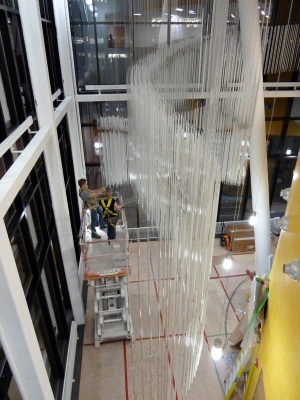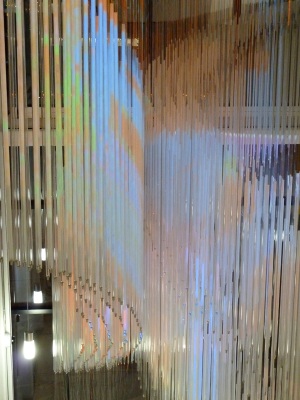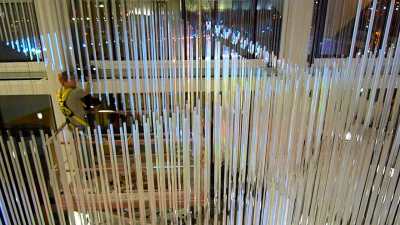 Sheridan Craft and Design Glass students sandblasted 2,200 glass tubes to suspend from the ceiling.
Sheridan Craft and Design Glass students sandblasted 2,200 glass tubes to suspend from the ceiling.
A 1,500-pound, 40-foot-long, two-story-tall glass installation was designed and installed by a team of 32 students and faculty from the Sheridan Craft and Design Glass Studio as part of a new building on the Sheridan College campus in Mississauga, Ontario, Canada. Titled Aurora Borealis, the piece was named after the naturally occurring phenomena of light display in the northern sky commonly known as the Northern Lights. The design stages of the project were completed during the 2010–11 academic year, and the installation wrapped up in November 2011. The project began when the four Sheridan craft and design studios were given the opportunity by the college to submit public installation design proposals for the new Sheridan Hazel McCallion Campus being built in Mississauga. Because of the two-story outer glass walls of the new building, the students and faculty of the glass craft and design studio felt it was an ideal place for a large-scale glass installation that would accentuate the natural light and become a permanent fixture. Glass students and faculty formed a project team and began viewing the architectural drawings and the construction space for inspiration.
 Images get manipulated and projected onto the glass by projectors.The slow natural movement of colourful light reflects the activity of the space.
Images get manipulated and projected onto the glass by projectors.The slow natural movement of colourful light reflects the activity of the space.
The team decided a duet of two types of approximately 2,200 thin glass tubes —some sandblasted to absorb light and some clear to reflect light—would bring on the desired effect of evoking the concept of collective effort. Meant to be interactive,the installation is equipped with three cameras that catch every movement occurring in the space. The images get manipulated and projected onto the glass piece by eight video projectors.The slow natural movement of colorful light reflects the activity of the space, therefore every visitor to the space somehow effects it.
During the day, the installation is designed to exploit the natural light afforded by the excess windows of the space. At night, real-time video cameras record images of people moving in the space, which are transformed into colored impressions and projected onto the suspended glass tubes that hang in varying lengths and curve.
 Aurora Borealis, 2011, courtesy: craft and design glass program, sheridan college
Aurora Borealis, 2011, courtesy: craft and design glass program, sheridan college
The Northern Lights are a result of a combination of charged particles, solar wind and the magnetic field of the Earth’s atmosphere. To the same effect, this piece utilizes human energy and the natural ability of glass to deflect and defuse light. While the Northern Lights are a naturally occurring phenomena, easily observed from the northern latitudes, the preparation for the installation of Aurora Borealis took months. The actual installation process spanned three days and was completed in the early hours of a November morning.
The glass installation was based on a group concept. In his article, Craft versus Design: Moving Beyond a Tired Dichotomy, Rafael Cardoso poses the idea that the craft-person’s potential value is realized only within a community of like-minded practitioners and users. This concept builds on the idea promoted by William Morris and the Arts & Craft movement that says craft is a shared practice. Koen Vanderstukken, head of the glass studio at Sheridan described the finished project in a prepared statement as a culmination of a unique learning experience and team effort, adding that the installation speaks to the imagination of anyone who views it.
—Suzann Caputo


